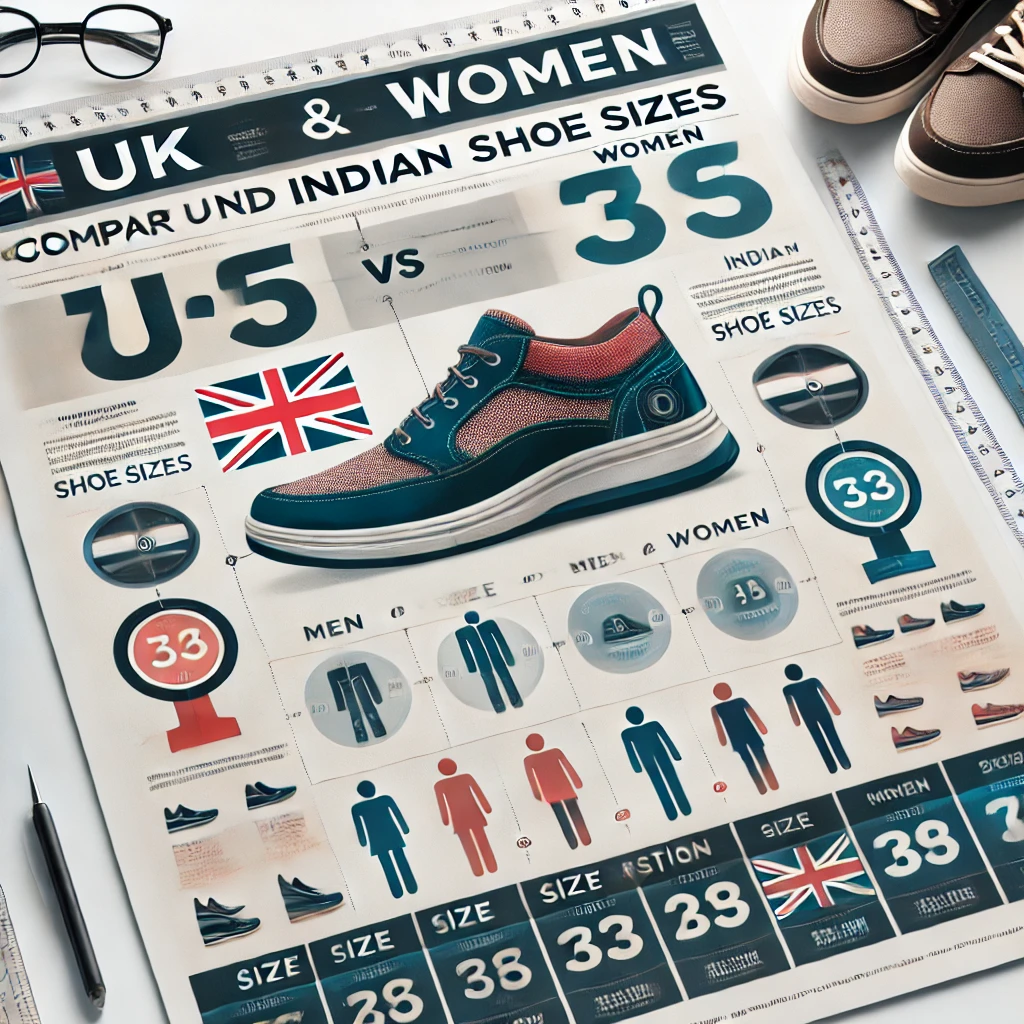Uk and India shoe size: Finding the correct shoe size is essential for comfort, especially when shopping for footwear from different countries. The UK and Indian shoe size systems are similar, but slight variations can make a difference in fit. This guide will help you accurately measure your foot, convert UK and Indian shoe sizes, and choose the right size when purchasing shoes.
Understanding UK and Indian Shoe Sizes
How Shoe Sizes Are Determined
Shoe sizes are based on foot length, but each country follows a different system:
UK shoe sizes are based on the length of the foot in inches, using a unique sizing scale.
Indian shoe sizes closely follow UK sizes, but variations exist depending on the brand.
Key Differences Between UK and Indian Shoe Sizes
Indian shoe sizes typically match UK sizes, but certain brands may have different measurements.
Manufacturing techniques and materials can slightly alter how shoes fit, even if the size number is the same.
Width measurements may differ between UK and Indian brands, affecting overall comfort.
How to Measure Your Foot Correctly
To ensure you get the best shoe size, follow these steps:
Gather Your Tools: You need a sheet of paper, a ruler, and a pencil.
Position Your Foot: Place your foot flat on the paper, with your heel against a wall.
Mark the Length: Draw a line at the tip of your longest toe.
Measure the Distance: Use the ruler to measure from the heel to the marked line.
Check Both Feet: Sometimes, one foot is slightly larger than the other. Use the longer measurement.
Match the Measurement to a Size Chart: Use a conversion chart to find the corresponding UK and Indian shoe sizes.
UK to India Shoe Size Conversion Chart
Men’s Shoe Size Conversion
| Foot Length (cm) | UK Size | India Size | US Size | EU Size |
| 24.0 | 6 | 6 | 7 | 40 |
| 24.5 | 7 | 7 | 8 | 41 |
| 25.0 | 8 | 8 | 9 | 42 |
| 25.5 | 9 | 9 | 10 | 43 |
| 26.0 | 10 | 10 | 11 | 44 |
| 26.5 | 11 | 11 | 12 | 45 |
| 27.0 | 12 | 12 | 13 | 46 |
Women’s Shoe Size Conversion
| Foot Length (cm) | UK Size | India Size | US Size | EU Size |
| 22.5 | 3 | 3 | 5 | 36 |
| 23.0 | 4 | 4 | 6 | 37 |
| 23.5 | 5 | 5 | 7 | 38 |
| 24.0 | 6 | 6 | 8 | 39 |
| 24.5 | 7 | 7 | 9 | 40 |
| 25.0 | 8 | 8 | 10 | 41 |
| 25.5 | 9 | 9 | 11 | 42 |
Factors That Affect Shoe Fit
Foot Width
Shoe width is not always included in standard-size charts.
People with wider feet may need to size up for a comfortable fit.
Shoe Material
Leather shoes tend to stretch over time, while synthetic materials do not.
Sports shoes usually have a tighter fit compared to casual or formal shoes.
Shoe Style
Sneakers, boots, sandals, and formal shoes all have different fits.
Some styles may require sizing up or down for optimal comfort.
Brand Variations
Each brand may have unique sizing, so always check their size charts before purchasing.
How to Choose the Right Shoe Size When Shopping Online
Measure Your Foot Accurately
Use the step-by-step guide above to measure your foot before placing an order.
Check the Size Chart
Each brand’s size chart may differ slightly from the standard conversion.
Read Customer Reviews
Look at customer feedback to see if the shoes run small, large, or true to size.
Consider Adjustable Features
Shoes with laces, straps, or elastic materials allow for better customisation in fit.
Look for Return Policies
Ensure the retailer offers easy returns if the shoes don’t fit as expected.
Best Practices for Buying Shoes That Fit Well
Shop in the Evening
Feet tends to swell slightly throughout the day, so it’s best to try on shoes in the evening.
Leave Some Space for Toes
Make sure there’s about a thumb’s width of space between your longest toe and the front of the shoe.
Wear the Right Socks
Try on shoes with the type of socks you plan to wear regularly.
Walk Around in the Shoes
Walk around in the shoes for a few minutes to test comfort and fit.
Break in New Shoes Slowly
New shoes may feel tight initially, but they usually loosen up after a few wears.
Common Mistakes to Avoid When Buying Shoes
Assuming All Brands Have the Same Fit
Different brands may have slight differences in their sizing. Always check brand-specific size charts.
Ignoring Width and Arch Support
Choosing shoes that don’t support your foot’s natural shape can lead to discomfort or pain.
Buying Shoes That Are Too Tight
Shoes that feel too tight at the store will likely remain uncomfortable.
Not Checking Online Reviews
Customer feedback can provide valuable insights into how a particular shoe fits.
Forgetting About Half Sizes
Consider insoles for a better fit if you’re between sizes. If you’re between sizes
Conclusion
Choosing the correct shoe size is essential for comfort and style. By following the measurement techniques, using conversion charts, and considering material and brand differences, you can ensure a perfect fit when buying shoes in UK or Indian sizes.
For more fashion insights, check out this article, Hair Color Shades.

